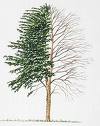Yellow Birch Tree Information
Images of Yellow Birch:






Yellow Birch grows in the following 27 states and provinces:
Connecticut, Georgia, Illinois, Indiana, Iowa, Kentucky, Maine, Maryland, Massachusetts, Michigan, Minnesota, New Brunswick, New Hampshire, New Jersey, New York, North Carolina, Nova Scotia, Ohio, Ontario, Pennsylvania, Rhode Island, South Carolina, Tennessee, Vermont, Virginia, West Virginia, WisconsinInformation about Yellow Birch:
The Betula Alleghaniensis is commonly known as the Gray Birch, Silver Birch, Swamp Birch as well as Yellow Birch.
The currently accepted scientific name of yellow birch is Betula alleghaniensis Britt. . A recognized form is B. a. forma fallax (Fassett) Brayshaw . Yellow birch hybridizes with low birch (B. pumila L. var. glandulifera Reg.). The hybrid is named B. xpurpusii C. K. Schneid . An additional entity formed by a backcross of B. xpurpusii and B. alleghaniensis has also been named: B. xmurrayana Barnes & Dancik .The range of yellow birch extends from southern Newfoundland, Cape Breton Island, Nova Scotia, New Brunswick, Anticosti Island, the Gaspe peninsula, and Maine west to southern and southwestern Ontario and Minnesota; south to northern New Jersey, northern Ohio, extreme northern Indiana and Illinois; and south in the mountains to South Carolina, extreme northeastern Georgia, and eastern Tennessee .Yellow birch is usually found singly or in small groups , growing with American beech (Fagus grandifolia), maples (Acer spp.), particularly sugar maple (A. saccharum), ashes (Fraxinus spp.), aspens (Populus spp.), other birches (Betula spp.), eastern white pine (Pinus strobus), red spruce (Picea rubens), and balsam fir (Abies balsamea) . In the Great Lakes-St. Lawrence forest region, yellow birch occurs in mixed forests with red pine (P. resinosa) and eastern white pine, and with eastern hemlock (Tsuga canadensis) . Yellow birch is a dominant, codominant, or important species in northern hardwoods-red spruce forest, northern hardwoods, transition hardwoods-eastern white pine, and in central hardwoods-eastern hemlock-eastern white pine . Yellow birch is codominant with yellow buckeye (Aesculus octandra) in western Great Smoky Mountains National Park . In the Catskill Mountains of New York, yellow birch is dominant in some spruce-fir stands and codominant in most others. It occurs as nearly pure stands on steep slopes at higher altitudes, or mixed with black cherry (Prunus serotina), mountain maple (Acer spicatum), red maple (A. rubrum) and paper birch (B. papyrifera) in open, scrubby stands on ridgetops . Small trees and shrubs associated with yellow birch include sweet birch (B. lenta), ironwood (Ostrya virginiana), American hornbeam (Carpinus caroliniana), striped maple (A. pensylvanicum), mountain maple, alternate-leaved dogwood (Cornus alternifolia), beaked hazelnut (Corylus cornuta), Atlantic leatherwood (Dirca palustris), witch-hazel (Hamamelis virginiana), American fly honeysuckle (Lonicera canadensis), American mountain-ash (Sorbus americana), Canada elderberry (Sambucus canadensis), Canada yew (Taxus canadensis), and mapleleaf viburnum (Viburnum acerifolium) . The largest concentrations of yellow birch are found in Quebec, Ontario, New Brunswick, Maine, upper Michigan, and New York. About 50 percent of the growing stock volume of yellow birch is in Quebec . Publications listing yellow birch as a dominant or codominant species in vegetation classification schemes include: The natural forests of Maryland: an explanation of the vegetation map of Maryland Field guide: Habitat classification system for Upper Peninsula of Michigan and northeast Wisconsin White Mountain landscapes A forest classification for the Maritime Provinces A classification of the deciduous forest of eastern North America Vegetation-environment relations in virgin, middle elevation forests in the Adirondack Mountains, New York Vegetation of the Great Smoky Mountains Classification of forest ecosystems in Michigan Some of the information provided here is attributed to:Sullivan, Janet. 1994. Betula alleghaniensis. In: Fire Effects Information System, [Online]. U.S. Department of Agriculture, Forest Service, Rocky Mountain Research Station, Fire Sciences Laboratory (Producer). , available at the USDA Fire Effects Information System (FEIS) website